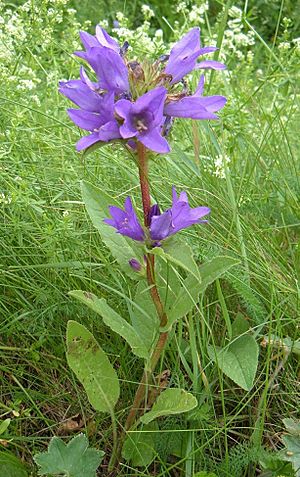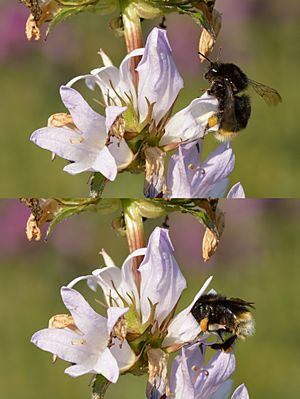Clustered bellflower facts for kids
Quick facts for kids Clustered bellflower |
|
|---|---|
 |
|
| Scientific classification | |
| Genus: |
Campanula
|
| Species: |
glomerata
|
Campanula glomerata, often called the clustered bellflower or Dane's blood, is a type of flowering plant. It belongs to the Campanula genus, which is part of the Campanulaceae family. This plant is also the special county flower of Rutland, England.
Contents
What's in a Name? (Etymology)
The name of this plant is quite easy to understand! The first part, Campanula, comes from a Latin word meaning "small bell". This describes the bell-like shape of its flowers. The second part, glomerata, means "tightly grouped". This refers to how the flowers grow together in a cluster at the top of the stem.
What Does It Look Like? (Description)
The clustered bellflower is a perennial plant. This means it lives for more than two years. It grows as a herbaceous plant, which means it has soft stems, not woody ones.
It usually reaches a height of about 20 to 60 centimeters (8 to 24 inches). Some plants can grow as tall as 90 centimeters (35 inches). Its stem is straight and has short, soft hairs.
The leaves near the bottom of the plant have stalks and are shaped like an oval or spear. They are also slightly heart-shaped. The leaves on the stem are spear-shaped and attach directly to the stem without a stalk. They also wrap around the stem a bit.
The plant's flowers grow in a cluster of 15 to 20 flowers. Each flower is about 2 to 3 centimeters (0.8 to 1.2 inches) wide. They are bell-shaped and have five dark violet-blue or purplish-blue petals. These flowers bloom from June to September.
Where Does It Grow? (Distribution and Habitat)
This plant is originally from the northern parts of Europe and Asia. You can find it from Britain all the way to Japan. In Europe, it grows almost everywhere, except for the very far north. It has also spread to North America, where it now grows naturally.
You can find the clustered bellflower in many different places. It likes forests, dry grasslands, and open woodlands. It also grows in grassy areas that are not too wet. Look for it along the edges of woods and next to roads or paths. It prefers soils that contain calcium, like chalky or limestone soils. It can grow at heights up to 1,500 meters (about 4,900 feet) above sea level.
Different Types (Subspecies)
There are many different types of Campanula glomerata! Scientists recognize about 15 different subspecies. A subspecies is like a special group within a species. These groups have small differences, often because they grow in different areas.
Some examples of these subspecies include:
- Campanula glomerata subsp. glomerata - found from Europe to Northwest China.
- Campanula glomerata subsp. cervicarioides - found in Southern Europe.
- Campanula glomerata subsp. farinosa - found from the Alps to Eastern Europe and Kazakhstan.
- Campanula glomerata subsp. speciosa - found from Southern Siberia to Japan.
Growing It in Gardens (Cultivation)
Many people love to grow the clustered bellflower in their gardens. You can find flowers in different colors, including white, pink, blue, and purple.
Gardeners have created many special types, called cultivars, for gardens. For example, 'Joan Elliott' has large violet flowers. 'Schneekrone' has beautiful white flowers.
The 'Superba' cultivar is a strong plant that grows up to 60 centimeters (24 inches) tall. It has rich blue flowers and has won an award from the Royal Horticultural Society. The pale purple 'Caroline' cultivar has also won this award.
Gallery
-
Funchal: Botanical garden
See also
 In Spanish: Campanula glomerata para niños
In Spanish: Campanula glomerata para niños










